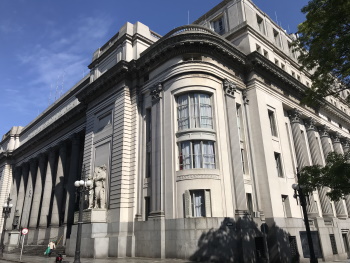Architecture Moderne du XX siècle de la Ville de Montevideo

Architecture Moderne du XX siècle de la Ville de Montevideo is part of the Tentative list of Uruguay in order to qualify for inclusion in the World Heritage List.
The 20th century modern architecture in Montevideo comprises a set of architectural works. They show the exchange of ideas with Europe. Notable works include Hospital de Clínicas and urban areas such as Parque José Batlle y Ordoñez. They date from between 1915 and 1965.
Map of Architecture Moderne du XX siècle de la Ville de Montevideo
Load mapThe coordinates shown for all tentative sites were produced as a community effort. They are not official and may change on inscription.
Community Reviews
Els Slots

Twentieth-century architecture is the main strength of Uruguay’s capital. Noteworthy examples of building styles from the 1920s to the 1950s can be found across the city. I visited a selection of them on a self-designed walking tour, divided into three clusters.
Cluster 1: Old City
The Old City isn’t the nicest part of town, especially outside of office hours. It does hold some fine buildings though:
- Edificio Centenario: its form fits its position on a street corner. Considered expressionist.
- Palacio Salvo (Photo 1): once the tallest structure in South America, and still its 95m tall tower is the landmark of the city center. Its eclectic style combines Art Deco, Art Nouveau and Neo-Baroque.
- Palacio Rinaldi: across the street from the Salvo, dwarfed by it but has fine Art Deco façade reliefs.
- Palacio New York: small building with a pretty Art Deco entrance.
- Palacio Lapido (Photo 2) also on the main boulevard, Avenida 18th July. 12 floors that curve around a corner.
Cluster 2: Parque José Batlle y Ordoñez
I then took an Uber to bridge the 5km to the area around Parque José Batlle y Ordoñez. This is the only cluster that is specifically mentioned in the official tentative site description:
- Parque: the park offers all kinds of sports and recreation areas, including a velodrome. It is also used commonly by driving schools – lots of corners to practice and hardly any traffic!
- Estadio Centenario: Uruguay’s national football stadium, built for the first World Cup in 1930. Very much a symbol of the country, it even features on the Uruguay Starbucks mug. Has a couple of Art Deco decorations, such as the tower (Photo 3).
- Hospital de Clinicas: across the road from the stadium. I’d call it Stalinist..
Cluster 3: Punta Carretas
I walked southward from the stadium to the next cluster in about 40 minutes. This is very much an upscale neighbourhood and pleasant to walk through. Modernist highlights here were:
- Edificio El Indio (Photo 4): known for its huge mural of an Indian (the Native American kind) on a horse.
- Edificio Mariposas: just to the left of the Indio. It also has facade drawings, in this case of butterflies.
- Casa Vilamajó: this was the home of architect Julio Vilamajó Echaniz and has glazed tile decorations. Its interior is open for tours on Wednesday and Saturday.
This area is also good for lunch, there are many options in varying price ranges. Afterward, you can take a direct bus back to the Old City (Ciudad Vieja), or do as I did and walk along the Rambla (that other Montevideo TWHS) for another 4km.
Read more from Els Slots here.
Assif
I found it extremely difficult to find out what is exactly meant to be included in this proposed nomination: the most obvious candidates - the Art Deco ensemble in the city centre for which Montevideo is known do not seem to be included. The only building explicitly mentioned in the description is the Hostpital de Clinicas, which is a rationalist concrete monster from the 50ies. Residences surrounding the Park Batllo y Ordonez are mentioned without naming the specific buildings. Perhaps the nearby Estadio Centenario (Centennial Stadium) with its rationalist viewing tower from the 30ies would be included too.
I personally didn't find any of the buildings surrounding the park, which seems to be the centre of the proposed nomination, to be especially worthy of a visit. Additionally, I could not find out about any special significance of these buildings for the history of architecture. It would be interesting to see how Uruguay proceeds with this nomination if it ever does.
Assif
Montevideo is known for its Ciudad Vieja (Old City) which is mostly in Art Deco style with Palacio Selvo as the most iconic building. When I visited Uruguay Palacio Selvo was not open to visitors. It had antennas hanging over its top which made any attempt to take a decent photo of the monument fail. On postcards some photo shop was discretely applied to remove it. Now I read they are planning to dismantle the antenna.
The Ciudad Vieja is not spectacular and despite the fact it is the only such example of Art Deco I visited I guess there are other better examples available.
Community Likes
Site Info
- Full Name
- Architecture Moderne du XX siècle de la Ville de Montevideo
- Country
- Uruguay
- Added
- 2010
- Type
- Cultural
- Categories
- Urban landscape - Latin American
- Link
- By ID
Site History
2010 Added to Tentative List
Site Links
Visitors
51 Community Members have visited.